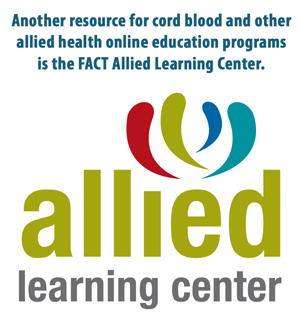Online Education
Listed below are programs produced by CBA, or in cooperation with the Foundation for the Accreditation of Cellular Therapy, FACT-NetCord or Save the Cord Foundation. Prevention, monitoring and validation are considered in a conversation among public and family cord blood bank representatives. August 2021 Management of Older Cord Blood Units Potential problems and solutions are discussed in a conversation among public and family cord blood bank representatives. July 2021 Reducing the Cost of Post-Transplant Care with Cord Blood New research indicates that umbilical cord blood may reduce the visits, lab studies and medications required after hematopoietic stem cell transplants. Shernan Holtan. May 2021 The Renaissance of Public Cord Blood Banks New developments in cord blood-derived therapies that can lead to expanded use of allogeneic cord blood. Ngaire Elwood. April 2021 HLA Matching for Cord Blood Units Cord blood selection is a complicated process in which many variables, including human leukocyte antigen profiles, are taken into account. Josefine Teeler. December 2019 
Driving Public Bank Inventory Utilization through Research and Development How to optimize a public cord blood inventory, develop clinical pathways and product pipelines, and leverage existing resources to diversify utility. Marcie Finney. September 2019 Alternative Donor Stem Cell Source A review of the advantages and disadvantages of choosing cord blood as a source of stem cells for allogeneic transplant, and the recent studies comparing donor sources. Karen Ballen. June 2019 Delayed Clamping and Its Impact on Cord Blood Collection Delayed cord clamping has become a hot topic and a source of debate. The term refers to the practice of letting a newborn’s umbilical cord pulse by postponing, rather than immediately, cutting the cord. Kate Girard. April 2019 Clinical Outcomes after Cord Blood Transplantation For many transplant physicians, the use of cord blood as a source of stem cells is seen as a last resort. Is it really a last resort or a better choice? The answer undoubtedly depends on many factors. Dr. Filippo Milano. March 2019 Toward a Sustainable Cord Blood Supply in the United States A report on a U.S. government-funded study by the RAND Corporation on the state of the cord blood industry, donation programs and ways to improve the sustainability of the National Cord Blood Inventory. Kandice Kapinos. February 2019 Manual and Automated Methods for Thawing of Cord Blood The manual and automated methods for thawing cord blood differ among cellular therapy centers. The recommended procedures that accompany the cord blood unit are not always adaptable to the disposals and reagents used by the clinical center. The discussion includes ways to improve cell recovery and a report of a multi-center study for harmonization of post thaw analysis of CD34 and CD45 cells. Drs. Diane Fournier and Roger Horton. March 2018 A review of the different methods cord blood banks use to obtain informed consent, and pros and cons of each method. Linda Moss. February 2018 Applying the FACT Cord Blood Standards in Private Banking How family cord blood banks can comply with the NetCord-FACT 6th Edition Cord Blood Standards, methods for overcoming challenges, and the benefits to achieving FACT accreditation. Drs. Arvin Faundo and Alexander Platz. January 2018 Cord Blood Outcome Data: How to Get it and How to Use it A discussion of getting and using cord blood clinical outcome data. What have cord blood banks done that has worked well and, once received, how the data can be used. Dr. Gesine Kögler and Andrea Darrow. December 2017 Cord blood banks differ in how they assess eligibility. The discussion includes collecting information upfront, at the collection sites, and an integration of the central bank and collection sites. Tips are offered for effective assessment of eligibility. Susana Gomez. October 2017 An overview of the specifications for cord blood units released for unrelated administration within the NetCord-FACT 6th Edition Cord Blood Standards. Gesine Kögler. March 2017 Clinical Applications of Expanded Cord Blood Progenitor Cells An update on the clinical use of ex vivo expanded cord blood stem and progenitor cells, shown to be safe in hematopoietic transplant and dose-intensive chemotherapy. Dr. Colleen Delaney. January 2017 How Cord Blood and Cord Tissue Can Help Drive Cutting-Edge Cell, Gene and Immunotherapies to Market A discussion of emerging applications of cord blood in cellular therapies and regenerative medicine, storage of multiple types of perinatal tissues, and ex vivo expansion of cord blood stem cells. Drs. Joanne Kurtzberg, Yael Margolin, Colleen Delaney and Frances Verter. November 2016 Quality Managers: How To Find, Utilize and Keep Them A cord blood bank’s hiring guide for the key position of quality manager. Debe Griffin and John Carpenter. November 2016 Quality Management in Cord Blood Banks How cord blood banks can design and install a quality management program. Dr. Robyn Rodwell. October 2016 Can We Prevent or Cure Type 1 Diabetes with Cord Blood? The CoRD Study A review of the Cord Blood Reinfusion in Diabetes (CoRD) Study in Australia that assesses whether the unique cells found in cord blood can stop immune destruction in the pancreas and prevent the development of diabetes in children. Dr. Maria Craig. August 2016 Step-By-Step Cord Blood Processing A discussion of volume reduction, application of HES and non-HES, and quality controls as they pertain to cord blood processing. Mike Halpenny. July 2016 Recycling Matters – Cord-Derived Stem Cell Treatment of Neonatal Disease The use of cord blood-derived stem cell therapy to improve lung disease and repair organ damage in premature infants. Dr. Bernard Thébaud. April 2016 Public Cord Blood Banking: A Global Cooperative Approach An overview of the status of public cord blood banking. Dr. Sergio Querol Giner. March 2016 Importing and Exporting Cord Blood Units A global look at cord blood import and export requirements. Dr. Etienne Baudoux. January 2016 Criteria for Banking a Cord Blood Unit How criteria for cord blood banking should be established, what the literature says and what governmental agencies require. Dr. Ngaire Elwood. December 2015 Autologous Cord Blood Stem Cell Applications for Pediatric Stroke and Acquired Hearing Loss An update on using cord blood to treat acquired perinatal stroke and hearing loss in children. Dr. James Baumgartner. December 2015 Methods To Assess Cord Blood Potency A discussion of the advantages and disadvantages of various methods for assessing cord blood potency. Dr. Joanne Kurtzberg. November 2015 Therapeutic Indications for Cord Blood – How Bright Is the Future? Representatives of the recently founded Cord Blood Association discuss their first-hand involvement in clinical and laboratory research using and engineering cord blood for cellular therapies and regenerative medicine. Dr. Joanne Kurtzberg, Dr. Colleen Delaney and Dr. Mahendra Rao. November 2015 Quality Cord in Cord Blood Banking An in-depth look at safety, purity and potency criteria for meeting NetCord-FACT Standards. Also the role of validations and quality assurance processes to ensure the best possible match for patients in need of a transplant. Dr. Susana Gomez. October 2015 What is the CBA and What Are Its Strategies for the Cord Blood Community? Several Cord Blood Association leaders describe the association’s progress and plans for addressing industry priorities, including advocacy, market expansion, quality assurance, public and health care provider education, and research and development. Dr. Joanne Kurtzberg, Jeffrey Crouse and Dr. Gesine Kögler. September 2015 Cord Blood Thaw, Dilute, Wash and Infusion-Relations Adverse Events A summary of current practices related to cord blood testing and preparation for administration and reports of adverse events. Includes a review of relevant NetCord-FACT Standards, as well as common citations. Dr. Catherine Bollard and Dr. Joanne Kurtzberg. March 2015 How to Build an Effective National Inventory of Publicly Available Cord Blood Units Although a cumulative national inventory of more than 240,000 units is stored in public banks, many of the units will never be used for transplant because of inadequate size. A new approach is needed to assure an inventory of high-quality units. Michael Boo. February 2015 Cord blood banks are at risk of many kinds of man-made and natural disasters. This webinar gives step-by-step guidance on how to prepare for, respond to and recover from a crisis. Alan Leahigh. November 2014 Cord Blood Transplantation for Genetic and Acquired Brain Disease Cord blood is being used to treat children with inherited metabolic diseases that affect the brain. Current clinical trials are exploring how autologous cord blood ameliorates brain damage caused by hypoxic insults or stroke. Dr. Joanne Kurtzberg. May 2014 Cord Blood Potency and Release Cord blood units are comprehensively evaluated not only before cryopreservation, but also prior to release for transplantation. The discussion includes current methods and technology for assessing potency using flow cytometric analysis of CD34+ cells, as well as assessments of CFC formation in a methycellulose-assay. Dr. Gesine Kögler. October 2013 Basic concepts in cryobiology related to ice formation in biological materials during transition from liquid to frozen phase. Examples are offered of “good” and “bad” cord blood cryopreservation thermal profiles. Dr. Paolo Rubella. July 2013 Measuring Viability of Cord Blood Products Methods for progenitor cell assessment, including flow cytometry to evaluate functional dose using early apoptosis to predict colony forming units (CFUs). Dr. Sergio Querol Giner. April 2013 |

 CBA offers access to a wide variety of online education programs for cord blood banking administrators and technicians. Many are archived webinars that are available free or at significantly reduced fees.
CBA offers access to a wide variety of online education programs for cord blood banking administrators and technicians. Many are archived webinars that are available free or at significantly reduced fees.